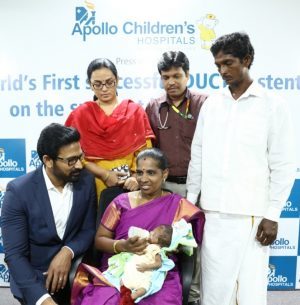- Home
- Editorial
- News
- Practice Guidelines
- Anesthesiology Guidelines
- Cancer Guidelines
- Cardiac Sciences Guidelines
- Critical Care Guidelines
- Dentistry Guidelines
- Dermatology Guidelines
- Diabetes and Endo Guidelines
- Diagnostics Guidelines
- ENT Guidelines
- Featured Practice Guidelines
- Gastroenterology Guidelines
- Geriatrics Guidelines
- Medicine Guidelines
- Nephrology Guidelines
- Neurosciences Guidelines
- Obs and Gynae Guidelines
- Ophthalmology Guidelines
- Orthopaedics Guidelines
- Paediatrics Guidelines
- Psychiatry Guidelines
- Pulmonology Guidelines
- Radiology Guidelines
- Surgery Guidelines
- Urology Guidelines
Apollo Children’s Hospitals Performs World’s first DUCTAL Stenting on the smallest baby

Apollo Hospitals, Asia’s largest and most trusted multi-specialty chain of hospitals has given a new lease of life to a two-week-old girl child by performing a life-saving ductal stenting procedure in a very small baby weighing 1.19 kg. This is the first procedure to be done in such a small baby in the world, without surgery.
The baby along with her mother, Revathy was brought to Apollo Children’s Hospitals in a critical condition with deep cyanosis (blueness all over the body) and oxygen saturation levels at 45% (normal 96-100%).
The investigations revealed that the child had a condition called Pulmonary Atresia with a ventricular septal defect (VSD). This means that supply to the lungs from the heart was totally cut off. The baby was surviving in the mother’s womb with the help of a tube (PDA) supplying to the lungs from the body tube (aorta). After birth, the PDA in the baby had nearly closed and there was no supply to the lungs, making the baby blue. It was important for the baby to have an adequate blood supply to the lungs to survive.
But being a very small baby, surgery was extremely risky, and therefore the doctors performed a procedure where they deployed a stent in the closing PDA to keep it open so that the baby could survive. This procedure is done only in a few centers in the world.
Explaining the procedure further, Dr. Muthukumaran CS, Consultant, Interventional Pediatric Cardiologist, Apollo Children’s Hospitals said, “We undertook the procedure as an emergency. As arteries in such babies are very small, we accessed the right femoral vein (thigh-vein which takes blue blood to the heart) through which we passed a wire, and with x-ray guidance reached the closing PDA through the heart. Being extremely low weight, the baby did give some trouble during and after the procedure, but our expert anesthetic team managed it very well. The heart rate dropped to 70, but we promptly stented the PDA and opened the tube. The baby’s saturation improved to 85% and she was taken off the breathing machine. The baby stayed in the ward for one more day and was discharged”.
Apollo Children’s Hospitals is equipped with state-of-the-art Azurion Cath Lab with 3D facilities, and it is the only children’s hospital to acquire this facility. It also has a surgical and ICU facility right next door for managing any eventualities. A number of heart conditions can be corrected by pinhole technique without scars. Apollo Children’s Hospitals has done more than 4000 such procedures in children, including valve replacement without surgery.
The child is at home and is recovering well. Once she grows, (she is now 1.8 kg), she will need to undergo a corrective surgery where a valved tube will be placed from right side of the heart to the lung tube.

Disclaimer: This site is primarily intended for healthcare professionals. Any content/information on this website does not replace the advice of medical and/or health professionals and should not be construed as medical/diagnostic advice/endorsement or prescription. Use of this site is subject to our terms of use, privacy policy, advertisement policy. © 2020 Minerva Medical Treatment Pvt Ltd